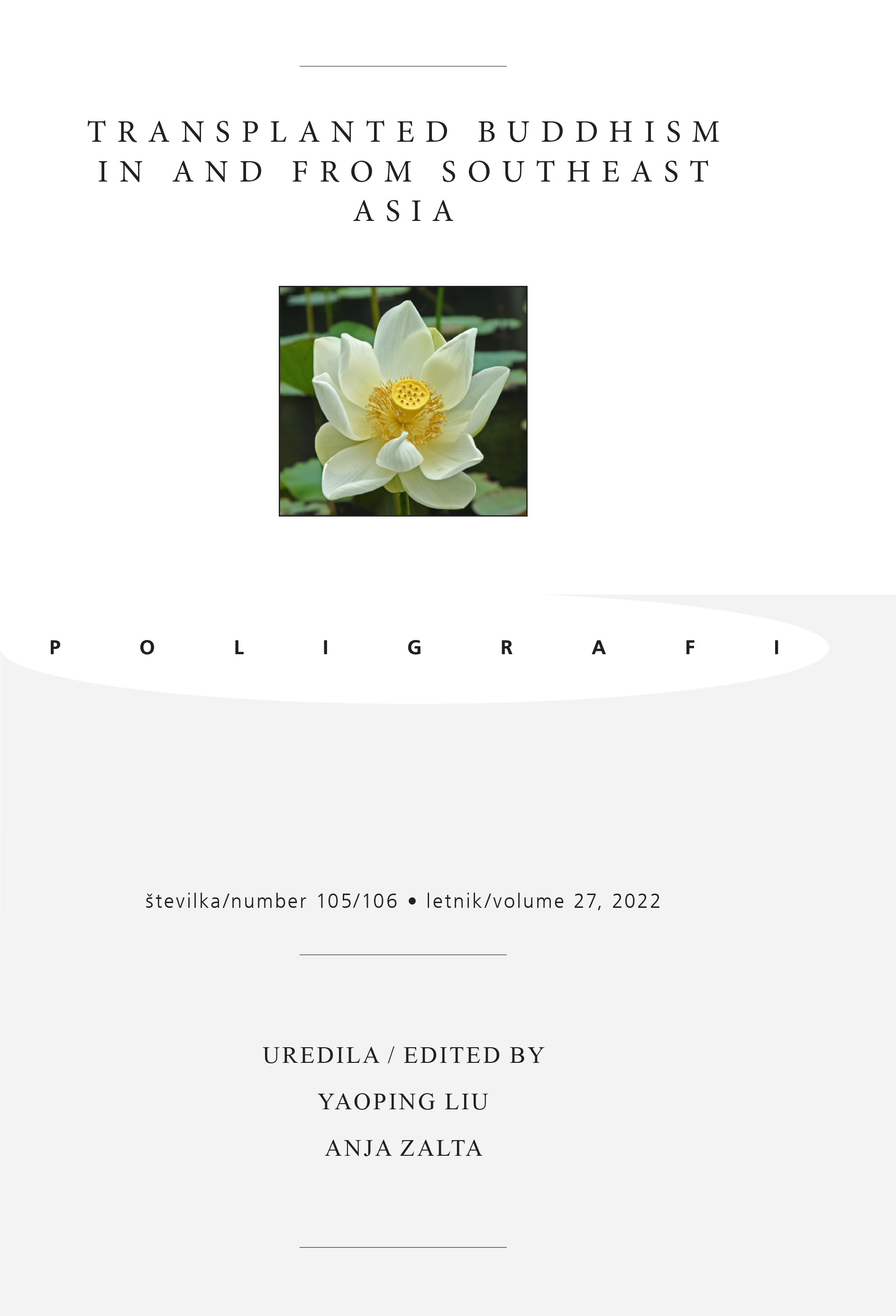Buddhism and an Ageing Society in Thailand as a Part of Suvarnabhumi Land
DOI:
https://doi.org/10.35469/poligrafi.2022.339Keywords:
Buddhism, Suvarnabhumi, Thailand, Southeast Asia, Ageing Society, Ageing PeopleAbstract
Thailand is a country in Southeast Asia that was once Suvarnabhumi land with a long history of 2600 years in parallel with the history of Buddhism here. Buddhism, the major religion in Thailand, was originally propagated by two Indian Buddhist monks named Sona and Uttara. Consequently, Buddhism has contributed to the Thai people for a long time. Obviously, in the first quarter of the 21st century, the situation of the elderly population around the world has been monitored and planned. Thailand is a country in Southeast Asia that has had an Ageing Society for more than 10 years. About 93.5% of the Thai population believe in Buddhism. According to Buddhism, elderly people are valuable because of their experience and contribution, and Buddhism always teaches gratitude. Therefore, to meet the challenge of an ageing society, appropriate age-related caregiving must be subject to accountability. In the Pāli Canon of Buddhism, there are many stories and teachings about the role and significance of elderly people along with caregiving, such as parents’ caregiving. The Buddha’s teachings have aimed to help provide human beings with physical, moral, emotional and wisdom development for the sake of their well-being. To follow the Buddha’s compassion, Buddhism in Thailand has been interpreted and applied to the well-being of ageing people.
Downloads
References
Department of Elderly Affairs, Ministry of Social Development and Human Security of Thailand. Measures to Drive the National Agenda on Aging Society (Revised Version). Bangkok: Amarintara, 2019.
Department of Elderly Affairs, Ministry of Social Development and Human Security of Thailand. The Strategic Plan of the Department of Elderly Affairs 20s, BE 2561- 2580. Bangkok: Samlada, 2018.
Institute for Population and Social Research, Mahidol University, and Foundation of Thai Gerontology Research and Development Institute (TGRI). Situation of the Thai Elderly 2017. Bangkok: Deuan Tula Printing House, 2019. http://www.dop.go.th/download/knowledge/th1552463947-147_1.pdf.
Kraiphibul, Puangthong “Older Person” [In Thai]. Accessed December 9, 2021. http://haamor.com/th.
Mahamakutarajavidhyalaya Foundation in the Royal Patronage. Tripiṭaka and Commentary 91 Books the 200th Anniversary of the Chakri Dynasty Rattanakosin, Vol. 26, 92. Bangkok: Mahamakutarajavidhyalaya Foundation in the Royal Patronage, 2003.
National Office of Buddhism. “Temple Registration System.” Accessed January 30, 2022. http://binfo.onab.go.th/Temple/Dashboard.aspx.
National Statistical Office. “Social, Cultural and Mental Health Conditions 2018.” Accessed January 5, 2022. http://www.nso.go.th/sites/2014/Pages/News/2561/N21-09-61-1.aspx.
Phra Dhammapitaka (P. A. Payutto). Dictionary of Buddhism. Bangkok: Sahadhammik, 2002.
PhraPhromKunaporn (P. A. Payutto). Buddhist Holistic Wellbeing. Nakhon Pathom: Wat Yanavesakawan, 2014.
Pornsiripong, Saowapa, Quanjit Sasiwongsaroj, and Yongyut Burasitdhi. “Preparedness of Buddhist Temples for an Aging Society.” Journal of Language and Culture 33, no. 1 (2014): 99–125. https://so03.tci-thaijo.org/index.php/JLC/article/view/21723/18736.
Somdet Phra Buudhaghosacariya (P. A. Payutto) Bhuddhadhamma (original edition), 40th edition 2021. https://www.watnyanaves.net/th/book_detail/302.
Stakeholder Group on Ageing. “Ageing.” United Nations. Accessed October 26, 2022. https://sustainabledevelopment.un.org/majorgroups/ageing.
Stuart, James. “Buddhist Belief in Respect of the Elderly.” Accessed January 20, 2022. https://classroom.synonym.com/buddhist-belief-in-respect-of-the-elderly-12085136.html.
Suan Kaew Foundation. “Wat Suan Kaew Aging Care Home.” Accessed January 30, 2022. https://www.kanlayano.org/home/projects/projects_10.php.
Sukimanil, Uthaiwan. “Concepts of Health Care for The Elderly under Buddhist Methods and Laws.”Journal of MCU Peace Studies 8, Supplement Issue (2020): 386–402. https://so03.tci-thaijo.org/index.php/journal-peace/article/view/241410/164884.
Thairath. “Open Thammaraksa Temple to help the elderly.” Accessed January 25, 2022. https://www.thairath.co.th/content/140303.
The Royal Institute. Definition of Elderly, Dictionary of the Royal Institute, 2003. Bangkok: Nanmee Books Public Class, 2003.
United Nations. World Population Ageing 2020 Highlights. New York: United Nations Publication, 2020. https://www.un.org/development/desa/pd/sites/www.un.org.development.desa.pd/files/undesa_pd-2020_world_population_ageing_highlights.pdf.
United Nations Population Fund (UNFPA). Aging in the Twenty-First Century: A Celebration and A Challenge. New York, and HelpAge International, London, 2012. https://www.unfpa.org/sites/default/files/pub-pdf/Ageing%20report.pdf.
United Nations. World Population Ageing 2017 Highlights. New York: United Nations Publication, 2017. https://www.un.org/en/development/desa/population/publications/pdf/ ageing/WPA2017_Highlights.pdf.
Watana, Somboon. “Concept of Elderly Care in Theravada Buddhism.” Journal of the Humanities and Social Sciences Burapha University 24, no. 44 (2016): 173–193. https://so06.tci-thaijo.org/index.php/husojournal/article/view/55972/46738.
Watana, Somboon. “Caregiving for Elder Parents in accordance with the Buddhist Doctrine in Thai Buddhist Families.” Journal of Community Development Research (Humanities and Social Sciences) 10, no. 2 (2017): 67–80. https://www.journal.nu.ac.th/JCDR/article/view/1821/1103.
Wiriyasombat, Rodchana, et al. “Effectiveness of Buddhist Doctrine Practice-Based Programs in Enhancing Spiritual Well-being, Coping and Sleep Quality of Thai Elders.” Pacific Rim International Journal of Nursing Research 15, no. 3 (2011): 203–219. https://he02.tcithaijo.org/index.php/PRIJNR/article/view/6512/0.
Downloads
Published
How to Cite
Issue
Section
License
Open Access Policy and Copyright
This journal provides immediate open access to its content on the principle that making research freely available to the public supports a greater global exchange of knowledge. Users are allowed to read, download, copy, distribute, print, search, or link to the full texts of the articles, or use them for any other lawful purpose, without asking prior permission from the publisher or the author.
Authors who publish with this journal agree to the following terms:
- Authors retain copyright and grant the journal right of first publication with the work simultaneously licensed under the terms of the Creative Commons Attribution license (CC BY) that allows others to share the work with an acknowledgement of the work’s authorship and initial publication in this journal.
- Authors grant the publisher commercial rights to produce hardcopy volumes of the journal for sale to libraries and individuals.
- Authors are able to enter into separate, additional contractual arrangements for the non-exclusive distribution of the journal’s published version of the work (e.g., post it to an institutional repository or publish it in a book), with an acknowledgement of its initial publication in this journal.




